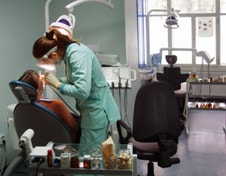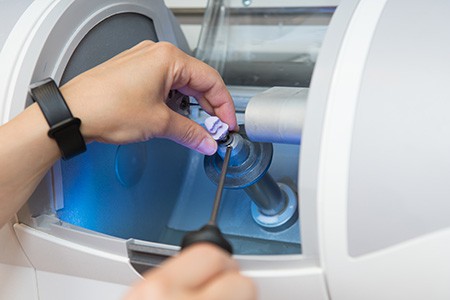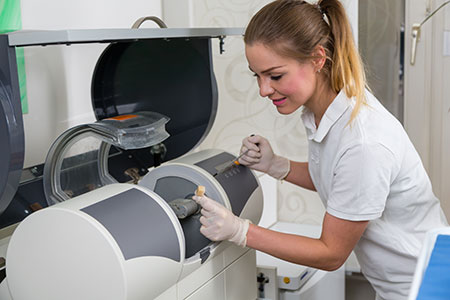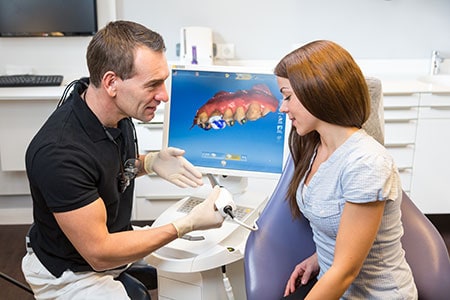CEREC System For Tooth Restoration In Toledo & Sylvania
At Our Dental Office in Sylvania

Broken or missing teeth can not only lead to embarrassment but also cause additional health problems. Repairing broken teeth or replacing missing teeth can help you avoid infection or even more serious health problems. Many people avoid dealing with such problems due to fear or because they are nervous about going to the dentist. But at Dental Health Associates of Sylvania, we have new technologies that will address these problems in one day, comfortably and in a relaxed atmosphere.
Dental Health Associates uses the CEREC System for tooth restoration. It is a computerized, state-of-the-art system that uses 3D photography and computer-aided technologies to create metal-free, all-ceramic tooth restorations. With the CEREC technology, our technicians are able to provide same-day service for porcelain tooth restorations. Same day tooth restorations can include dental crowns, inlays, onlays, and veneers.
The CEREC process chemically bonds the ceramic material to your tooth, ultimately saving as much healthy tooth as possible. The pressed ceramic material provides the same hardness and look of human enamel, and it is made to last a lifetime. In fact, CEREC tooth restorations can actually add strength to your tooth! Best of all, we can make it unique to you with special characterization, custom staining, and glazing to make sure it matches the rest of your teeth. The process is easier and faster than traditional fillings, crowns or veneers. Most are completed in just one appointment.
Here are some benefits to receiving a CEREC restoration:
- A natural looking filling
- A quick, one-time appointment
- A healthier, metal-free filling
- No ill-fitting temporaries
- A restoration that matches the color and size of your existing teeth
- A durable restoration with strong material
CEREC Treatment Details

Once our dentist determines that a CEREC same-day restoration is the appropriate treatment, the tooth receiving the restoration and the area surrounding that tooth are anesthetized and prepared. A digital impression is taken of the tooth and surrounding area, and the information is processed through the CEREC software, which creates a virtual model of the tooth. The restoration is designed based on this information.
The restoration’s design is then sent electronically to the milling unit of the CEREC machine. The restoration is milled from a block of high-quality porcelain or composite to the exact specifications of the design. The milling process takes about 20 minutes, all while the patient waits. After the restoration has been fabricated, it is buffed or polished for a translucence similar to natural tooth enamel. The restoration is then placed over the tooth and bonded into place with a strong dental adhesive. Any last-minute adjustments are made for fit or comfort.
The entire process can take as little as 90 to 120 minutes. This is convenient for anyone that desires high-quality tooth restorations in a single convenient appointment. The same-day restoration process also eliminates the need for problematic or loose temporaries.
Our dentist explains how to care for the new CEREC restoration. Most can be brushed and flossed normally, and should be checked by a professional at least once a year. To preserve the integrity of the restoration, patients should avoid biting or chewing hard items like nut shells, bones and ice.
We want to make your visit here at Dental Health Associates a pleasant one. Our CEREC tooth restorations involve fewer injections, less drilling, immediate results, and most importantly, less time away from your busy life! We know your smile is important to you, so let us make it the best it can be! Schedule a consultation by calling our Sylvania office today!
Candidates for CEREC Dental Restorations

CEREC dental restorations provide comprehensive benefits and can address various oral health and cosmetic needs. However, they may not be suitable for some concerns, such as a small cavity that only requires a tooth-colored filling or a tiny chip that may be corrected with dental bonding. Patients with these concerns may qualify for CEREC dental restorations.
- Severe tooth decay: moderate to severe tooth decay weakens the tooth structure, making it more vulnerable to fracture and breakage. A CEREC dental crown can save the natural tooth and avoid the need for a tooth extraction.
- Mouth or jaw injury: A car accident or sports injury can cause one or more teeth to chip, crack, or break. A CEREC dental restoration restores the strength of the affected teeth and covers imperfections.
- Restoration after root canal treatment: CEREC dental crowns may be a part of your root canal treatment plan. A root canal cleans out decay from the tooth root system and covers and seals the area to prevent further deterioration. A CEREC dental crown reinforces the remaining tooth structure and saves the tooth.
- Missing teeth: A CEREC dental crown can replace a missing tooth. A dental implant, or titanium post, is placed in the jaw to replace the lost tooth root, and an abutment connects the post to a CEREC dental crown. The dental implant and crown look and function like a natural tooth and root.
- Cosmetic imperfections: CEREC dental restorations can cover tooth imperfections, such as crooked teeth, severe tooth discoloration, gapped teeth, and misshapen teeth. CEREC veneers address tooth chips and cracks with a thin ceramic shell.
CEREC dental restorations are versatile and are often included in a small makeover or full mouth restoration.
FAQs
How long can a CEREC dental crown last?

The average dental crown made with CEREC technology lasts 10 to 15 years, similar to a traditional dental crown. You can make your CEREC crown last longer with these tips:
- Avoid grinding or clenching your teeth.
- Brush and floss daily.
- Schedule regular dental check-ups and teeth cleanings.
- Don’t chew on hard foods, including candy and ice.
- Quit smoking.
- Don’t use your teeth as tools (to perform tasks like opening a package).
- Reduce the amount of sugary foods and drinks you consume.
CEREC crowns may need repair or replacement if you experience a mouth injury, tooth decay, or chip or fracture the crown.
What does the acronym CEREC mean?
CEREC stands for “Chairside Economical Restoration of Esthetic Ceramics,” meaning you get an aesthetically-pleasing dental restoration made with ceramic material while you’re still in the dental chair. A single-visit dental restoration with the CEREC system reduces your discomfort and time away from work.
CEREC dental crowns rely on CAD-CAM technology, which stands for computer-aided design and manufacturing. The system creates the restoration quickly using digital impressions for a precise cut of the ceramic block and an exact fit for your needs.
Why choose a dentistry office with CEREC technology?
The CEREC system is advanced technology. When you go to a dentistry practice that offers CEREC restorations, such as Dental Health Associates of Sylvania, you choose a dental team at the forefront of advanced dental procedures and technologies willing to invest in high-tech equipment to improve the patient experience and results.
How much do CEREC restorations cost?

CEREC crowns cost more than traditional dental crowns because of the high-grade materials used to fabricate these restorations during your appointment. CEREC restorations are customized for optimal durability and aesthetics. Conventional crowns made of gold or porcelain-fused-to-metal (PFM) are made in a dental lab and take several weeks to prepare. The average cost for CEREC dental crowns in 2023 was $1,430 per tooth. Many factors contribute to the price, but dental insurance may cover up to 50% of the expenses for CEREC restorations.
The type of tooth and CEREC material will influence the cost. For example, a front or anterior tooth is cheaper than a posterior or back tooth because they are smaller and use fewer materials to create anterior crowns. The location and experience of the dentist will also affect the price of CEREC restorations.
CEREC crowns are more costly because they are a premium type of restoration made in the office and don’t require temporary crowns or uncomfortable gooey impressions. The CEREC computer-aided design and computer-aided manufacturing software is complex and uses an intraoral scanner, milling unity, and a special firing oven. This state-of-the-art equipment increases the cost of the restorations, and it takes a higher skillset to scan, design, and fabricate CEREC crowns.
Depending on the material, traditional crowns range from $500 to $3,500. Porcelain and ceramic carry higher price tags but offer the most natural appearance with long-lasting results. Most patients are blown away by the CEREC system and same-day dental crowns.
What are the disadvantages of CEREC technology?
There are more pros than cons to CEREC dental restorations. The CAD/CAM technology is efficient, offering same-day procedures with no temporary crowns or impressions. They save you time, are less invasive, and require little to no tweaking because the digital milling machine is pinpoint accurate and makes restorations that fit perfectly the first time. However, CEREC restorations are more expensive than traditional crowns and may fracture if made too thin. Patients who grind or clench their teeth are not good candidates for CEREC restorations.
CEREC crowns require more tooth structure removal than traditional crowns. These restorations are not a good fit for all teeth, such as a tooth fracture that reaches below the gumline. That’s because the intraoral scanner can’t capture the damage beneath the gums and requires a traditional impression to achieve the best-fitting crown.
What dental restorations can be made with CEREC technology?
The CEREC CAD/CAM system fabricates dental crowns, inlays, and onlays. Crowns are caps that fit over the remaining tooth structure after removing decayed or damaged areas. An inlay is a dental restoration that fits in the cusps or points on the top portion of the tooth where food is chewed. An onlay fits up and over the tooth’s cusps and provides more coverage of the tooth’s surface than an inlay. Onlays are preferred for damage to the biting surface of the tooth.
Will dental insurance cover CEREC dental crowns?

Your dental plan may cover a portion of the cost of CEREC crowns, just like traditional restorations. Out-of-pocket expenses for CEREC crowns average $953 or between $530 and $1,876, depending on your dental coverage. Most insurance providers cover 50% of essential or medically necessary dental work. Our dentist recommends confirming the details of your plan before your appointment.
Are CEREC crowns as durable as traditional crowns?
CEREC restorations tend to last just as long as traditional crowns and withstand the same chewing intensities. The high-quality materials of CEREC crowns make them look even better than conventional crowns. However, metal crowns may be more resistant to wear and tear because they have a stronger bond with the tooth’s surface. A traditional crown fits better over a tooth fractured beneath the gum line.
Studies show CEREC crown materials have an exceptional survival rate. Lithium disilicate glass-ceramic crowns having a 97.2% survival rate after 10 years, and the Vita Mark II CEREC crowns made with feldspar ceramic may last up to 30 years.


